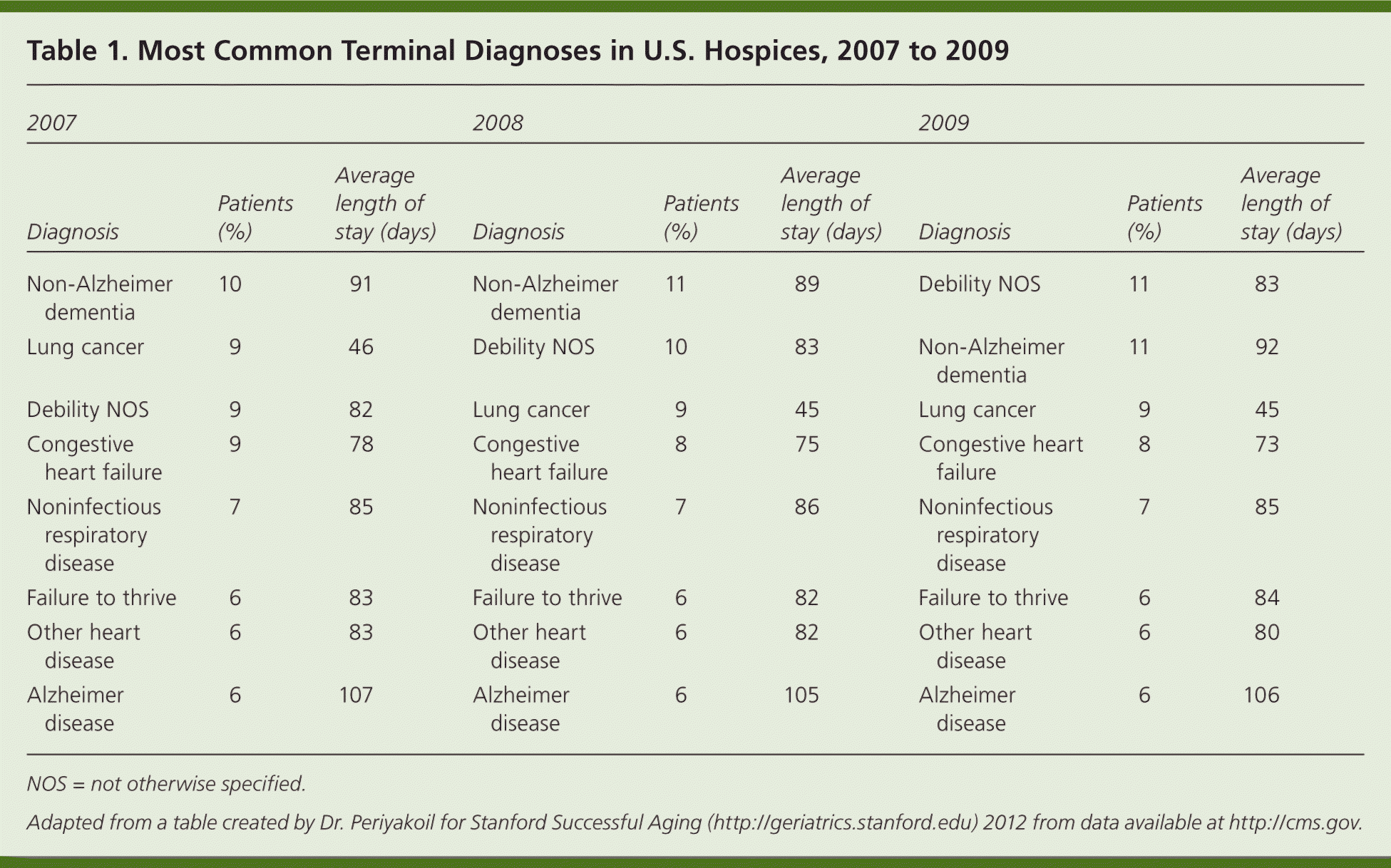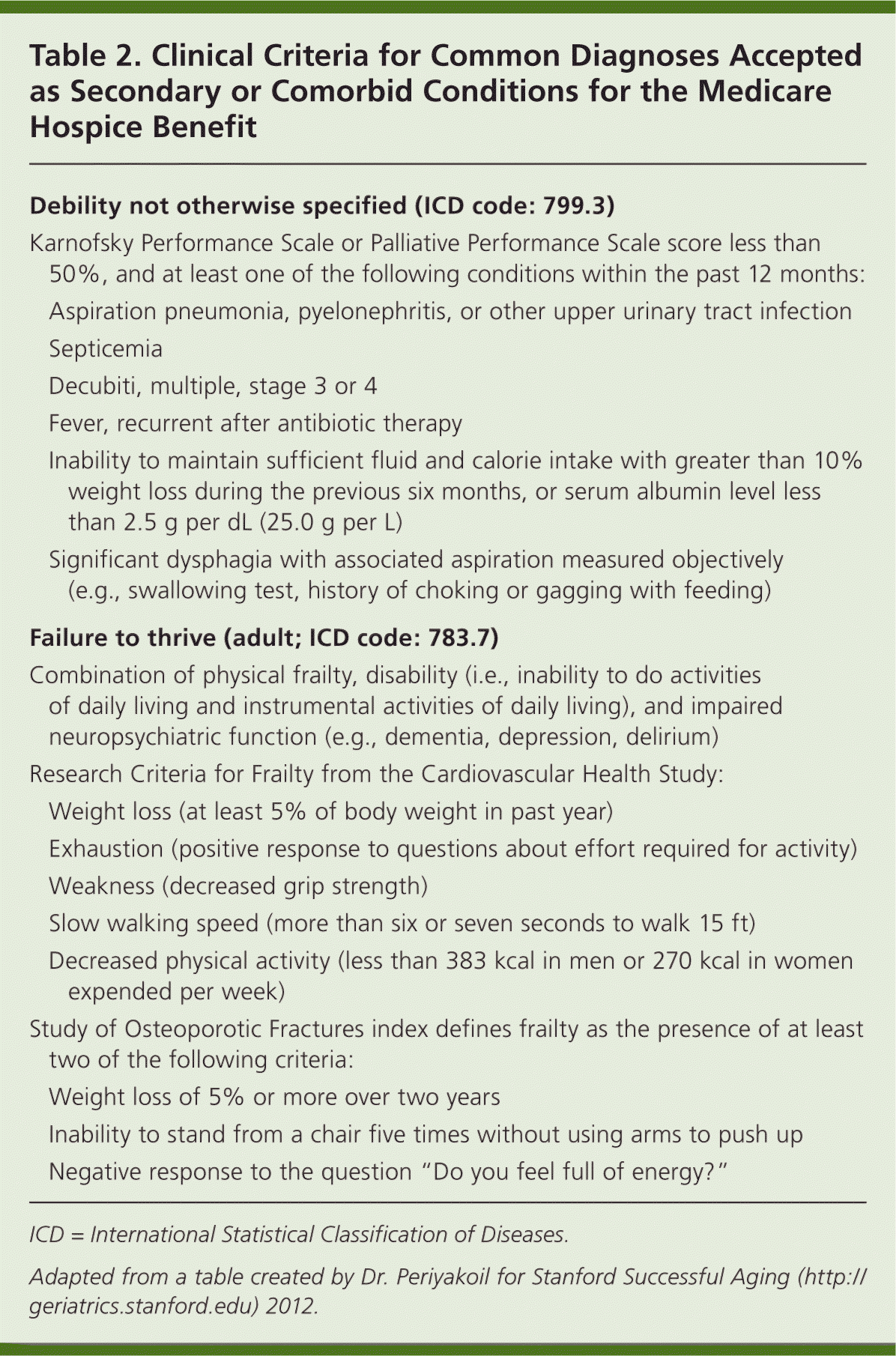
Am Fam Physician. 2013;88(6):363-368
Related articles: Functional Decline in Older Adults and A Team Approach: Comprehensive Evaluation for Functional Decline in Older Patients
Author disclosure: No relevant financial affiliations.
Roughly one in two Americans has a chronic disease, and an estimated 1.7 million die each year from chronic illness.1 Most will have a chronic illness for a prolonged time before they die. Until 2005, lung cancer was the most common terminal diagnosis in hospices. Now, however, debility not otherwise specified (NOS) has surpassed lung cancer as the most common diagnosis (Table 1). Debility NOS and failure to thrive (FTT) are often diagnosed in frail older adults who may not have a specific terminal illness, but one or more comorbid chronic illnesses and progressively declining functional status. Frail older adults often have poor appetite, weight loss, increased fatigue, and progressively declining functional status, and may be eligible for services provided by the Medicare hospice benefit if they have other primary terminal diagnoses.2,3 In August 2013, the Centers for Medicare and Medicaid Services issued a rule that debility NOS and adult FTT can no longer be listed as principal hospice diagnoses, but rather, secondary comorbid conditions4 (Table 2).

| 2007 | 2008 | 2009 | ||||||
|---|---|---|---|---|---|---|---|---|
| Diagnosis | Patients (%) | Average length of stay (days) | Diagnosis | Patients (%) | Average length of stay (days) | Diagnosis | Patients (%) | Average length of stay (days) |
| Non-Alzheimer dementia | 10 | 91 | Non-Alzheimer dementia | 11 | 89 | Debility NOS | 11 | 83 |
| Lung cancer | 9 | 46 | Debility NOS | 10 | 83 | Non-Alzheimer dementia | 11 | 92 |
| Debility NOS | 9 | 82 | Lung cancer | 9 | 45 | Lung cancer | 9 | 45 |
| Congestive heart failure | 9 | 78 | Congestive heart failure | 8 | 75 | Congestive heart failure | 8 | 73 |
| Noninfectious respiratory disease | 7 | 85 | Noninfectious respiratory disease | 7 | 86 | Noninfectious respiratory disease | 7 | 85 |
| Failure to thrive | 6 | 83 | Failure to thrive | 6 | 82 | Failure to thrive | 6 | 84 |
| Other heart disease | 6 | 83 | Other heart disease | 6 | 82 | Other heart disease | 6 | 80 |
| Alzheimer disease | 6 | 107 | Alzheimer disease | 6 | 105 | Alzheimer disease | 6 | 106 |

| Debility not otherwise specified (ICD code: 799.3) | |
| Karnofsky Performance Scale or Palliative Performance Scale score less than 50%, and at least one of the following conditions within the past 12 months: | |
| Aspiration pneumonia, pyelonephritis, or other upper urinary tract infection | |
| Septicemia | |
| Decubiti, multiple, stage 3 or 4 | |
| Fever, recurrent after antibiotic therapy | |
| Inability to maintain sufficient fluid and calorie intake with greater than 10% weight loss during the previous six months, or serum albumin level less than 2.5 g per dL (25.0 g per L) | |
| Significant dysphagia with associated aspiration measured objectively (e.g., swallowing test, history of choking or gagging with feeding) | |
| Failure to thrive (adult; ICD code: 783.7) | |
| Combination of physical frailty, disability (i.e., inability to do activities of daily living and instrumental activities of daily living), and impaired neuropsychiatric function (e.g., dementia, depression, delirium) | |
| Research Criteria for Frailty from the Cardiovascular Health Study: | |
| Weight loss (at least 5% of body weight in past year) | |
| Exhaustion (positive response to questions about effort required for activity) | |
| Weakness (decreased grip strength) | |
| Slow walking speed (more than six or seven seconds to walk 15 ft) | |
| Decreased physical activity (less than 383 kcal in men or 270 kcal in women expended per week) | |
| Study of Osteoporotic Fractures index defines frailty as the presence of at least two of the following criteria: | |
| Weight loss of 5% or more over two years | |
| Inability to stand from a chair five times without using arms to push up | |
| Negative response to the question “Do you feel full of energy?” | |
Frailty is a state of increased vulnerability resulting from age-associated decreases in physiologic and functional reserves that limit the body's ability to cope with increased demands from daily and acute stressors. Its hallmarks are weakness, fatigue, weight loss, poor grip strength, and slow gait. Unlike cancer or heart disease, in which there is a focal point of pathology, frailty is characterized by diffuse and diminishing physiologic reserves and decreased ability to cope with noxious insults. FTT is diagnosed in patients with the triad of physical frailty, disability, and impaired neuropsychiatric function. Other conditions that can present as FTT include undiagnosed and untreated anemia, depression, delirium, and dementia; patients also may present with fatigue, weakness, and impaired physical and cognitive performance. Older adults who are experiencing elder abuse or neglect may have positive results on frailty assessments, but the symptoms may reverse partially when they are removed from the abusive environment. A thorough assessment is indicated to confirm the diagnosis and determine the optimal management of any underlying reversible conditions.
If an older adult continues to have FTT or has progressive debility after the common and reversible causes of frailty are detected and managed, he or she is likely transitioning to terminal frailty. At this point, the physician should discuss the goals of care with the patient and the patient's family, educate them about terminal frailty, and encourage them to identify a surrogate and complete advance directives and Physician Orders for Life-Sustaining Treatment (http://www.polst.org). Early consultation about palliative care promotes dignity-conserving care5,6 through shared decision making and management of pain and distressing nonpain symptoms. Many older adults wish to die at home; this is possible for those with an excellent social support system. Those with a suboptimal social support system should be transitioned to a living situation that can provide support.
Patients with severe frailty who wish to forego ineffective and burdensome procedures should be referred to palliative care. National data show that during 2009, the average length of stay in hospice for persons with debility NOS was 83 days, and 84 days for those with FTT. Although this length of stay is nearly twice that of patients with cancer, it is well within the first benefit period of 90 days allowed by the Medicare hospice benefit. However, if debility NOS and FTT can no longer be listed as principal diagnoses for hospice qualification, these older adults may be subjected to ineffective interventions, including repeated emergency department visits and hospitalizations that are burdensome and expensive, and erode their quality of life. Early referral of frail older adults to palliative care will help them design an end-of-life plan that augments dignity,5,6 facilitates shared decision making, and avoids burdensome and ineffective interventions. It is also desirable that as the U.S. population ages, requisite system changes be made that allow older adults with primary FTT or debility NOS to be treated with a palliative focus of care and be able to receive hospice benefits.
